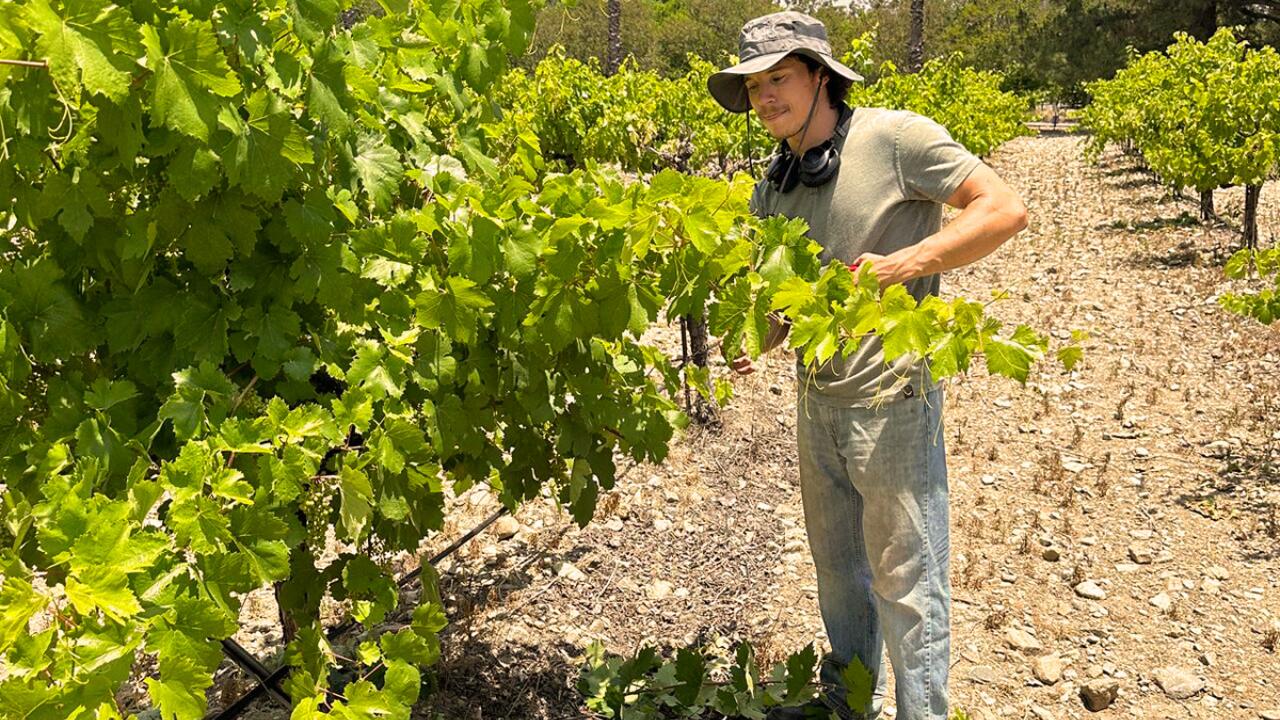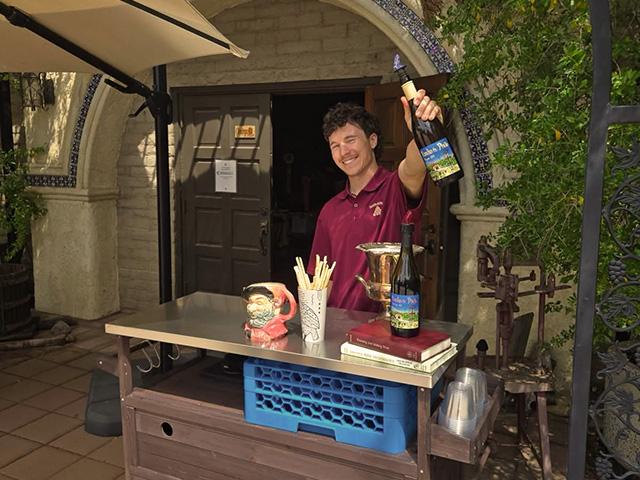
Learning from the Vine Up: How One Winemaker Is Building on a Family Tradition
“Being part of this multigenerational tradition feels quite natural to me,” said Matthew Tibbetts, who bottled his first wine as a six-year-old at his family’s winery.
Rancho de Philo, in the Cucamonga Valley east of Los Angeles, has been a family-owned and -operated winery since his great grandfather founded it in 1974. The six-acre vineyard grows historic Mission grapes rooted more than 50 years ago and boasts multiple generations of family involvement. As its chief operating officer, Matthew is actively engaged in the family business and is looking to elevate its legacy with fresh wines and new audiences.
After earning a bachelor’s degree in viticulture and enology at California Polytechnic State University, San Luis Obispo, he applied to UC Davis Continuing and Professional Education’s Winemaking Certificate Program to deepen his knowledge.
“My inspiration lies in carrying a torch passed from previous generations of my family,” he said. “I must learn from the best to be the best.”
Now halfway through the program, Matthew is “learning the right tips at the perfect times,” applying his knowledge to address concerns in the family vineyard, such as canopy management and Pierce’s disease.

How did you hear about the program, and what made you decide it was the right step for your winemaking journey?
I learned about this program after a post-harvest meeting with winemaker Jeremy Leffert. He spoke highly of it and told me it would align closely with my goal of becoming an industry leader. I decided the UC Davis Winemaking Certificate Program was for me after hearing other people’s stories. I reached out to more than 10 people on LinkedIn who completed their certificates for some advice, and I heard only positive things.
What were your goals going into the program? Have those evolved since you started?
My goal has been to gain and retain the knowledge of a winemaker from a scholarly point of view. Not only has the program given me ample opportunity to do that, but I’ve also learned how important staying in touch with classmates is. My goals have increased in complexity as the program continues. (I’m always wanting to understand the next “big idea.”)
Now that you’re halfway through, how would you describe your experience with the program so far?
It’s like a college class, but the people in the program—both instructors and classmates—are more engaged. My passion for winemaking, paired with this new sense of community, makes the experience special.
What topics or courses have stood out to you the most, and why?
For most of my life, I’ve been working in the cellar and lab—not so much vineyard—so the Viticulture for Winemakers class stands out above the rest in terms of new knowledge. I did a deep dive into rootstock selection, soil types, commercial viticultural pest management and many other topics that were previously foreign to me. Being part of a family with a small vineyard, I felt right at home talking with classmates and my instructor.
You mentioned learning “the right tips at the perfect times.” Could you share an example of a moment when coursework aligned perfectly with a challenge you were facing at Rancho de Philo?
At Rancho de Philo, we were behind on our canopy management, which I knew before entering the program. But the week after the shoot-thinning lectures, I took it upon myself to drive to our small vineyard and get to work. It was the first time the vines had been thinned in their more than 50 years of existence.
I took an experimental approach and only thinned two of our six blocks of head-trained Mission. We’ll see if it makes a difference in the fall, but it put a smile on my grandparents’ faces to see me working to improve their backyard.
Can you describe how your coursework has informed your strategy for dealing with Pierce’s Disease at the vineyard?
Before the program, my knowledge of Pierce’s disease was very basic. I knew what affected vines looked like and my grandpa’s recommended spray schedule for the glassy winged sharpshooter. Since the program, I have a better grasp of what happens to vines with Pierce’s disease and where those bugs like to hang out. It came as no surprise that many of our affected vines were nestled next to a citrus grove. Classmates also connected me to various forums and organizations in Temecula—a wine region nearby—that focus on Pierce’s disease and other prevention methods.
What are some specific techniques or practices you’ve implemented at Rancho de Philo that stem directly from what you’ve been learning in the certificate program?
Since harvest is still a few months away, many of the viticulture techniques like shoot thinning, water deficits and disease prevention are top of mind. The program also provides resources for all sorts of price ranges. I learned that testing the health of our vineyard is quite affordable.
I’ll draw on the knowledge I gained from the winemaking courses when crush is underway. My plan is to expand the number of SKUs available to the public, and my processing techniques will support that. This year, I will make history at our small winery by being the first to try something new with Mission grapes.
What has been the most valuable insight or tool you’ve gained so far that’s had a direct impact on your vineyard management?
Scouting the vineyard. It seems obvious, but knowing where your hotspots are has a big impact on how you treat them.
Grow your expertise
Learn more about how the Winemaking Certificate Program can help you turn your passion into a career. Contact an enrollment coach to get started.
Looking ahead, what part of the program are you most looking forward to completing?
I’m very excited for the Wine Stability and Sensory Analysis course. I took a sensory analysis class at Cal Poly SLO recently, and it will be insightful to understand it from another professor’s perspective.
How do you envision the knowledge and skills from this program contributing to the future of Rancho de Philo?
We make one wine—Cream Sherry. It’s been awarded best in California year after year. While continuing this tradition is extremely important, I believe the skills from this program will help me create more variety for our consumers. That will open the door to a new audience, increase traffic and lead to more cash flow.
The skills from the program will also lead to proactive, rather than reactive, vineyard management. They will help us grow high-quality grapes to make premium wine.
Do you have long-term goals for your career in winemaking—perhaps expanding your role at the family vineyard or launching new projects?
My long-term goals are to launch new wines for Rancho de Philo, make vineyard management a well-oiled machine and expand our customer base.
What advice would you give to others considering enrolling in the Winemaking Certificate Program—especially those already working with vineyards or family operations?
Ask lots of questions. Attend class meetings. Take notes. Revisit your notes and lectures as much as possible, because this information is vital. Stay connected with your instructors and classmates after the course ends. I made a Facebook group for my classmates, and we post there quite often.
How has this journey influenced your passion for viticulture and winemaking?
It has solidified my long-term goals as a winemaker and helped me focus on the practice outside of harvests. I’ve always known there’s no better feeling than seeing your project go into bottles that can be shared with the world. This journey plays a significant role in bringing that feeling to fruition.
